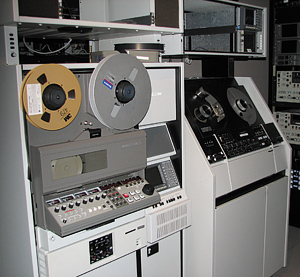The Evolution of Videotape Formats, Part 2

Last month, we said that in spite of recent technological developments, videotape is not yet dead. In fact, it is enjoying a robust life even today in the world of digital disk recorders. Why? It is still an inexpensive, reliable, trouble-free way to store and transport high-quality video, both SD and HD.
We also looked at the venerable 2-inch quad video recorder, the industry mainstay from 1956 until the late 1970s, at which time 1-inch (SMPTE Type C in the United States) video recorders took over. Helical scan video recorders, of which 1-inch is one, existed for some time before they became broadcast-quality machines. Unlike 2-inch machines, their tape is wrapped around a spinning scanner in a configuration that resembles the Greek capital letter omega; thus they are sometimes referred to as "omega wrap" machines.
This wrapping pattern requires tape that is much thinner and more flexible than 2-inch tape. It is so thin and flexible that as it travels through the transport, it is subject to stretching and flexing which effectively changes its lateral dimension (length) dynamically. This generates dynamic time base errors that are sufficiently serious that, until the development of the digital time base corrector, omega wrap machines could not successfully record and playback composite color signals. Early helical scan recorders were used as monochrome industrial machines, but were useless for color television recording.
ONE-INCH TAPE MACHINE

Two Type C 1-inch VTRS The digital time base corrector, one of the first digital video devices to be used, made it possible for 1-inch machines to record and playback high-quality color video. The 1-inch Type C machine that resulted was the standard for broadcast quality video recording for at least a decade to follow. As opposed to the 2-inch format's single audio track, the 1-inch machine had three audio tracks. Two of these tracks could be used for stereo audio, while the third track, which was of slightly inferior quality to the other two, was used for timecode. This machine, with its timecode track and its helical scanning footprint, wherein each track laid down on the tape represented an entire field of video, made possible "stunt modes" including off-speed and reverse play, still image, slow motion, and others, as well as the capability to do electronic editing.
Helical scanning, in which the movement of the video heads describe a helix-like pattern, became the standard method of videotape scanning used in all subsequent videotape recording formats. Where the quadruplex heads of the 2-inch recorders laid down tracks that were perpendicular to the longitudinal dimension of the tape, helical-scan heads lay down diagonal tracks that are much longer, the track angle being about 2.5 degrees with respect to the longitudinal dimension of the tape.
One-inch tape was the last analog professional videotape recording format that recorded composite video, in which the color signals were modulated onto a 3.58 MHz subcarrier and interleaved into the luminance signals. It was also the last professional video recording format that used open reels of tape: all subsequent formats used tape cassettes.
The next professional video recording formats to be introduced marked the brief component analog video era. These included Betacam, introduced in 1982 and followed by Betacam SP in 1986; and about contemporaneously with Betacam SP, M-II. These formats recorded component analog color difference signals on 1/2-inch tape in cassettes. Betacam records on oxide tape, but Beta SP and M-II use magnetically "hotter" metal particle tape, which affords the ability to record signals of higher bandwidth.
While these formats were initially developed as newsgathering formats, they (particularly Beta SP) enjoyed some use in applications requiring higher quality. As is the case with omega wrap, the names of these formats describe the configuration of the tape around the scanner. Betacam uses a "beta wrap," wherein the tape, when threaded onto the scanner, resembles the shape of a Greek lowercase letter beta. Likewise, M-II uses an "M-wrap," the threaded tape resembling an upper case letter M.
THE TROUBLE WITH D-1
The first professional digital video recording format was D-1, which was introduced in 1986. The D-1 format recorded component digital signals on 3/4-inch (19mm) oxide tape in cassettes. The signals recorded by D-1 are ITU-R 601 component SD signals. D-1 was one of the last professional tape formats that laid down tracks separated by guard bands, which are small spaces between adjacent tracks.
Most, if not all, subsequent formats used azimuth recording, wherein a given track is laid down at an azimuth angle of around 30 degrees with respect to the tracks preceding and following it. No guard band is used; the edges of adjacent tracks overlap. The angular azimuth difference between adjacent tracks permits sufficient rejection of the unwanted adjacent signals.
D-1 was used in many professional mastering and graphics applications for many years, but it is remembered as a costly and sometimes troublesome format. Problems with interchange of tapes between D-1 machines were common. While the D-1 format was developed by committee (several SMPTE committees, actually), a less expensive alternative digital format, D-2, was developed by Ampex.
D-2 recorded composite digital signals (simply a digital representation of the analog composite waveform), also on 3/4-inch oxide tape. This format, which was introduced shortly after D-1, is still in the process of being phased out by some television network operations.
Ampex subsequently developed and introduced the DCT format, which also recorded 601 SD component video on 3/4-inch oxide tape in cassettes. This format used mild digital compression. DCT found some use in post production, but was never used by the broadcast networks to any degree.
TODAY'S DIGITAL RECORDING FORMATS
This brings us to the later digital recording formats, and the HD recording formats. The analog Betacam formats were joined in the early 1990s by Digital Betacam, which records 601 component digital video on half-inch metal tape in cassettes, using mild digital compression. At around that same time, D-5 was introduced as a successor to D-1 using half-inch tape.
While some early HD recorders recorded analog video signals on 1-inch tape, the preponderance of HD recorders have recorded digital signals. Early digital HD recorders were 1-inch machines, recording uncompressed HD component signals. These devices were physically large and very expensive, and other, smaller formats were developed that are now used in everyday HD tape recording applications.
The HD machines enjoying the most frequent use today include the Panasonic HD-D5 recorders and the Sony HDCAM lines. Both of these lines of recorders lay down component digital HD signals on half-inch metal particle tape in cassettes. The hotter metal particle tape facilitates higher bandwidth, and thus higher digital data rates, than oxide tape. Both of these types of recorders use a degree of mild digital compression in order to accommodate HD signals. They both offer models that record a large number of audio channels, as well.
As previously mentioned, we are currently well into the age of digital disk recorders, but digital videotape is still used daily, and we will not see it disappear in the foreseeable future. It affords a reliable, economical, nonbulky method to exchange and archive television programming.
Randy Hoffner is a veteran TV engineer. He can be reached through TV Technology.
Get the TV Tech Newsletter
The professional video industry's #1 source for news, trends and product and tech information. Sign up below.

